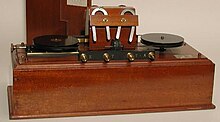Magnetischer Detektor

Der magnetische Detektor war eines der ersten Geräte, mit denen es möglich war, drahtlose Funksignale über Kopfhörer zu empfangen. Obwohl nicht ganz so empfindlich wie andere Detektoren zur damaligen Zeit, wurden magnetische Detektoren wegen ihrer Zuverlässigkeit bevorzugt auf Schiffen eingesetzt.
Geschichte
Als Guglielmo Marconi im Jahre 1902 Experimente zur transatlantischen Nachrichtenübertragung durchführte, stellte er fest, dass die bisher verwendeten Kohärer für den Empfang der sehr schwachen Signale zu unempfindlich und auch zu unzuverlässig sind und hielt Ausschau nach besseren Systemen. Der Magnetische Detektor gehörte auch zur Funkausrüstung der Titanic und den Schwesterschiffen.
Funktion
Ein endloses Band aus Eisen läuft, ähnlich wie bei einem Tonband, an den Polen von Dauermagneten vorbei und wird dadurch magnetisiert. Zugleich wirkt auf das Band der hochfrequente Strom aus der Empfangsantenne ein, der es, je nach dessen Amplitude, stärker oder schwächer entmagnetisiert. Dadurch wird die verbleibende Magnetisierung mit der Amplitude des HF-Signals moduliert. Anschließend wird das magnetisch niederfrequent beschriebene Band an einer Tonabnehmerwicklung vorbeigeführt, deren Ausgangsspannung auf einen Kopfhörer gegeben wird, wodurch die Modulation des empfangenen Signals hörbar gemacht wird.
Weblinks
- Der Empfänger der Titanic auf schmegel.eu
Auf dieser Seite verwendete Medien
Autor/Urheber: Autor/-in unbekannt
Main Page, Lizenz: CC BY-SA 3.0
Magnetic detector in early radio receiver, used to detect Morse code radiotelegraphy signals broadcast by early spark radio transmitters between 1900 and 1920. Invented by Guglielmo Marconi, the magnetic detector was used in shipboard radio receivers because of its complexity. It was used for only a few years, until it was replaced by crystal and vacuum tube detectors. The magnetic detector was the "official" detector employee by Marconi Company.
It consisted of a continuous loop of fine iron wires, which rotated at a rate of 7-8 cm per second around two pulleys turned by a motor or windup mechanism.
The wire passed through two coils of copper wire, which were in the magnetic field of two horseshoe magnets. The radio signal from the receiver was applied to one coil, and the second was connected to an earphone. As it passed through the first magnet, the wire was magnetized longitudinally in one direction, then due to hysteresis the magnetization was "flipped" to the opposite direction as it passed through the second magnet. In the absence of a radio signal, the flipping of the magnetization always occured at the same place inside the coil, so the magnetic field through the coil was constant. However, when a radio signal was applied to the first coil, it created an oscillating magnetic field that demagnetized the iron wire, so the flux through the second coil changed, inducing a voltage that was heard as a click in the earphones. (information from G. W. Pierce (1910) Principles of Wireless Telegraphy, McGraw-Hill, p. 145-163)}It functions in the following way.
A cable without end is consisted several bits of wire insulated with silk. This cable passes in the throats of two pulleys between which it is reasonably tended. The pulleys, pulled by a clockwork communicate to the cable a translatory movement of a few centimetres a second. The cable passes in the axis of a reel rolled up on a tube of glass. This reel is inserted in the circuit antenna-ground of reception. Around this first reel and according to the same axis, one lays out one second reel which is connected to a telephone earphone. A couple of magnets whose of the same poles name are touched is laid out with the top of the cable and the reels.
Here what one observes with such a detector; if the cable is motionless, when a wave train arrives, the magnetic state present of the cable is modified and the telephone earphone makes hear a slapping. But if another wave train is presented, one understands nothing any more because the magnetic state of iron does not change any more. If the cable is moving, its passage in front of the magnet will determine a certain basic magnetization and, if a signal is presented, this magnetization will be modified and the consequence of this modification is a current armature in the circuit of the telephone with the corresponding noise.It will be thus for each high frequency signal.
